
mtreasure/iStock/Getty Images
The Pequot Indians called cranberries “i-bimi,” or “bitter berry,” according to “The Color Code,” a book about the health benefits of colorful foods. Their high acid and low sugar content is what makes them bitter, but it is also what makes their juice so effective against the prevention of urinary tract infections. Fresh cranberries and unsweetened cranberry juice are low in calories and rich in vitamins, minerals and a number of important antioxidant compounds. Cranberry juice is particularly effective in preventing urinary tract infections and also helps prevent recurrent kidney stones, according to “The Encyclopedia of Healing Foods.”
Acid Content
A food’s value on the pH scale offers a way to quantify its acid content relative to other foods and substances. On the scale, which runs from 0 to 14, pure water is neutral and has a value of 7. Acidic substances are valued below 7, while basic, or alkaline, substances are valued above 7. Most foods contain enough organic acids to give them acidic values on the pH scale; many fruits and most vegetables, dairy products, grains and meats have slightly acidic values and are considered low-acid foods. High-acid foods are valued below 4.6. Unsweetened cranberry juice is a high-acid beverage, with a median pH value of 2.4. Compared with cranberry juice, lemon juice is as acidic, lime juice is slightly more acidic and grapefruit juice is slightly less acidic.
pH Nature
A food’s pH value doesn’t determine its pH nature in the body, because the metabolic process affects the type of compounds the food produces during its breakdown. Citrus fruits, for example, are high-acid foods that contain potassium citrate, a mineral compound that’s metabolized into potassium bicarbonate. Because bicarbonate is highly alkalizing, citrus fruits are moderately to highly alkaline-forming in the body. Most fruits and their unsweetened juices are alkaline-forming in the body; however, cranberries and cranberry juice rank among the few acid-forming fruits and fruit juices. Along with plums and prunes, cranberries contain benzoic and quinic acids, which convert to hippuric acid in the liver and overpower any alkalizing compounds they produce.
Health Benefits
Fresh cranberries and unsweetened cranberry juice are excellent sources of vitamin C and good sources of manganese, copper, thiamin and potassium. Fresh, whole berries are also rich in soluble and insoluble fiber, which you can retain in beverage form by adding whole cranberries to a blender-made smoothie. Cranberries contain proanthocyanidins, or PACs, which prevent bacteria from adhering to the urinary tract, which is why cranberry juice is so effective in the prevention of urinary tract infections. Additionally, cranberries are loaded with phenols and other antioxidant compounds. According to “The 150 Healthiest Foods on Earth,” Catherine Neto of the University of Massachusetts-Dartmouth studied several compounds isolated from cranberries and found that they inhibited the cell growth of leukemia and lung, cervical, prostate and breast cancers.
Considerations
A long-term diet emphasizing acid-forming foods can result in chronic low-grade metabolic acidosis, a condition characterized by a slightly acidic body pH. Since cells and tissues require a slightly alkaline environment for proper function, metabolic acidosis can set the stage for numerous diseases and conditions, including cancer, chronic fatigue, inflammation and osteoporosis, according to “The Acid Alkaline Food Guide.” Although cranberries are one of the rare acid-forming fruits, their numerous health benefits make them a healthy component of many diets. Most commercial cranberry juice is high in added sugar, which decreases its antioxidant content and substantially increases its caloric content as well as it’s acidifying nature in the body. Therefore, it’s best to sweeten pure cranberry juice with naturally sweeter juices such as orange juice.
Related Articles

Is Wheat Grass an Alkalizing Food?
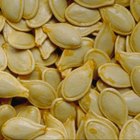
Alkaline & Acidic Foods & Drinks

Different Types of Fruits & Vegetables

Is Applesauce an Alkaline Food?
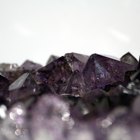
Types of Valuable Crystals
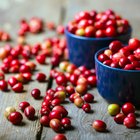
Is Cranberry a Fruit or Vegetable?

Fruit & Water Diet
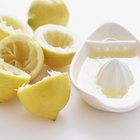
Why Does Lemon Juice Stop Apples From ...

What Fruits Are Considered Aphrodisiacs?
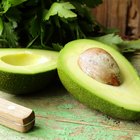
Fruits High in Zinc
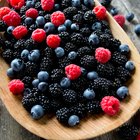
Foods That Score High on the ORAC Scale

Difference Between Clover & Orange ...

What Is Certo Used For?

What Is Agave Syrup?

Food Sources of Betaine

Nutrition Information on Blueberries

What Foods Are High in Malic Acid?

Types of Greek Fruits & Vegetables

Pomegranate Juice & Acne

Information About the Orange Fruit
References
- “The Encyclopedia of Healing Foods”; Michael Murray, N.D., et al.; 2005
- “The Color Code”; James A. Joseph, Ph.D., et al.; 2002
- “The 150 Healthiest Foods on Earth”; Jonny Bowden, Ph.D., C.N.S.; 2007
- “The Acid Alkaline Food Guide”; Dr. Susan E. Brown, et al.; 2006
- Oklahoma State University; The Importance of Food pH in Commercial Canning Operations; William McGlynn
- Worcester Polytechnic Institute; Cranberry Juice Creates Energy Barrier that Prevents Bacteria from Adhering to Cells, New Study Shows; July 2008
Writer Bio
Based just outside Chicago, Meg Campbell has worked in the fitness industry since 1997. She’s been writing health-related articles since 2010, focusing primarily on diet and nutrition. Campbell divides her time between her hometown and Buenos Aires, Argentina.
Photo Credits
mtreasure/iStock/Getty Images